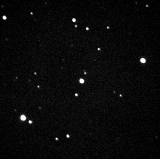
WASP-1
Encyclopedia
WASP-1 is a metal rich
magnitude
12 star
located about 1240 light-years away in the Andromeda
constellation
.
WASP-1b
was discovered by the SuperWASP
project using the transit method.
Metallicity
In astronomy and physical cosmology, the metallicity of an object is the proportion of its matter made up of chemical elements other than hydrogen and helium...
magnitude
Apparent magnitude
The apparent magnitude of a celestial body is a measure of its brightness as seen by an observer on Earth, adjusted to the value it would have in the absence of the atmosphere...
12 star
Star
A star is a massive, luminous sphere of plasma held together by gravity. At the end of its lifetime, a star can also contain a proportion of degenerate matter. The nearest star to Earth is the Sun, which is the source of most of the energy on Earth...
located about 1240 light-years away in the Andromeda
Andromeda (constellation)
Andromeda is a constellation in the northern sky. It is named after Andromeda, the princess in the Greek legend of Perseus who was chained to a rock to be eaten by the sea monster Cetus...
constellation
Constellation
In modern astronomy, a constellation is an internationally defined area of the celestial sphere. These areas are grouped around asterisms, patterns formed by prominent stars within apparent proximity to one another on Earth's night sky....
.
Planetary system
In 2006 the extrasolar planetExtrasolar planet
An extrasolar planet, or exoplanet, is a planet outside the Solar System. A total of such planets have been identified as of . It is now known that a substantial fraction of stars have planets, including perhaps half of all Sun-like stars...
WASP-1b
WASP-1b
WASP-1b is an extrasolar planet orbiting the star WASP-1 located over 1000 light-years away in the constellation Andromeda. In recognition of the regional support given to the project on La Palma, the discoverers gave the planet the alternative designation Garafia-1.-Orbit and mass:The planet's...
was discovered by the SuperWASP
SuperWASP
SuperWASP is an international academic organisation performing an ultra-wide angle search for transiting extrasolar planets with the aim of covering the entire sky down to ~15th magnitude.-Equipment:...
project using the transit method.

